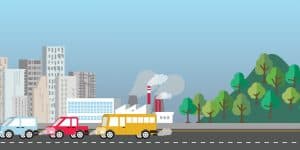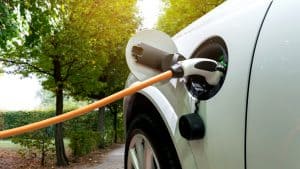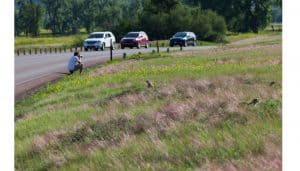GREEN Streets
Transforming Transportation Systems to Reduce Pollution
 Environmentalists have a longstanding negative view of the transportation sector. The tailpipe emissions produced by internal combustion engine (ICE) vehicles exacerbate climate change, adversely affecting the global ecosystem's stability. In response, environmental engineers and scientists evaluate atmospheric-related challenges and develop sustainable solutions. While some cities are working to phase out ICE vehicles on roads, in favor of electric vehicles (EVs) and other zero emissions forms of transit, there are practical steps that can be taken (outlined below) to help reduce road pollution.
Environmentalists have a longstanding negative view of the transportation sector. The tailpipe emissions produced by internal combustion engine (ICE) vehicles exacerbate climate change, adversely affecting the global ecosystem's stability. In response, environmental engineers and scientists evaluate atmospheric-related challenges and develop sustainable solutions. While some cities are working to phase out ICE vehicles on roads, in favor of electric vehicles (EVs) and other zero emissions forms of transit, there are practical steps that can be taken (outlined below) to help reduce road pollution.
 EVs significantly shrink the transportation sector's carbon footprint. As emissions decrease, ecological researchers are evaluating the effects of transportation-related noise pollution on wildlife conservation. Professionals developed sustainable solutions to tackle cars’ and road construction's impact on local ecosystems.
EVs significantly shrink the transportation sector's carbon footprint. As emissions decrease, ecological researchers are evaluating the effects of transportation-related noise pollution on wildlife conservation. Professionals developed sustainable solutions to tackle cars’ and road construction's impact on local ecosystems.
Challenges Between Transportation and Wildlife (Emphasis on Noise)
Nearly 88% of the U.S. population owns a car. We are also the third most populated country, creating a significant amount of noise pollution from transportation. Although roads produce all kinds of air pollution (think smog), and other public health hazards, this article will focus on a less-emphasized form of pollution; namely, noise pollution. Humans can shelter themselves from the pollution emanating from roads by retreating into their homes, while animals cannot escape.
Changing Road Systems and Vehicles to Protect Wildlife From Noise Pollution
In highly polluted regions, various species face endangerment. Many animals rely on noise to locate food sources, protect themselves against predators, navigate areas, and more. As noise pollution worsens, biodiversity may decrease, creating environmental degradation.
 Prairie dogs rely on their high-pitched barks to inform their pack of nearby predators. When individuals build roads near a colony, vehicle noise limits the species’ ability to send messages. Urbanization caused a 95% decline in the prairie dog population, driving endangerment.
Prairie dogs rely on their high-pitched barks to inform their pack of nearby predators. When individuals build roads near a colony, vehicle noise limits the species’ ability to send messages. Urbanization caused a 95% decline in the prairie dog population, driving endangerment.
Researchers also evaluated the effect of noise pollution on birds. They found a correlation between noisier regions and lower reproduction rates. Birds have a more challenging time locating mates and protecting their eggs in high pollution areas.
As more animals experience the adverse effects of noise pollution, the global ecosystem suffers. Professionals examined the various sources of ecological degradation and developed sustainable solutions. They identified the top road system alterations and vehicles that reduce noise, protecting biodiversity.
Road System Solutions
Professionals build the U.S. road systems for convenience and limited topographical impact. They generally follow natural bends and divots in Earth's surface, reducing the energy needed for and price of construction. If professionals focused on local wildlife species during the development process, they could implement change and enhance conservation.
Individuals could decrease the noise associated with the transportation system by reducing speeding and traffic. Texas's 130 highway has a stretch with an 85-mph speed limit. If it lowered this to 70 mph, it could significantly decrease noise pollution.
Construction professionals can also limit the number of roads by developing wider highways. That would reduce the number of cars on backroads in rural areas with higher wildlife populations. Upgrading highways to decrease potholes and other noise-generating features are also essential.
States can increase their streets’ quietness by repaving them. Some companies also track the sustainability of road construction materials, like cement, decreasing pollution where they can. Reducing general degradation can increase local biodiversity levels.
Communities may further reduce noise pollution by improving the public transportation system. Trains, buses, and shared rides can decrease the number of vehicles on the roads, limiting sound. Professionals can also add noise barriers to their highways to protect local wildlife.
When traveling on interstates in heavily populated regions, you may notice tall cement walls alongside the right lanes. These structures are sound barriers, protecting residents and biodiversity from adverse noise pollution effects. Researchers evaluated the feature's impacts on sound and their effectiveness.
In one study, residents noticed a significant decrease in noise disturbances. The transportation sector can also regulate the type of vehicles on the roads, further decreasing human-induced sounds.
Vehicle Solutions
As wildlife conservation becomes a common concern, professionals evaluate the differentiation in noise pollution among various vehicles. They discovered cars with fewer emissions produce less sound. Hydrogen fuel-cell vehicles significantly decrease noise pollution by eliminating conventional engine-related noises.
 Similarly, EVs are extremely quiet because of their lack of mufflers. Loud car sounds when starting, accelerating, and revving derive from the engine and muffler, which are absent in EVs. They are also more controllable, reducing squealing and chirping.
Similarly, EVs are extremely quiet because of their lack of mufflers. Loud car sounds when starting, accelerating, and revving derive from the engine and muffler, which are absent in EVs. They are also more controllable, reducing squealing and chirping.
Electric buses also decrease noise pollution and the number of vehicles on the roads. Volvo conducted an urban sound study in Sweden, finding mental and physical challenges deriving from vehicle noises. It discovered the adverse effects of transportation sounds on the brain during sleep.
Rather than allowing the body to reach an elongated state of rest, noise pollution keeps a portion of the mind activated and on alert. Volvo responded to the challenges by developing 4,000 electric buses. Unlike conventional, diesel-powered vehicles, the buses produce little to no transportation sounds. They also create zero noise when stationary at bus stops.
When urban areas adopt electric public transportation technologies, they can conserve biodiversity and human health. Wildlife resides outside of cities, and decreasing vehicle sounds could alter their habitat preferences.
Benefits of Quieter Cities
When urban areas decrease noise pollution, they can increase bird reproduction rates. Additionally, quieter cities protect caterpillars' health, helping them develop into butterflies and other pollinating creatures. Promoting pollination is essential to the global ecosystem's stability, enhancing the longevity of resources.
Cities with low noise pollution also improve human health. Individuals have the freedom to rest and meditate in quieter locations, increasing their mental well-being and immune systems.
Article by Jane Marsh
Author bio:
Jane works as an environmental and energy writer. She is also the founder and editor-in-chief of